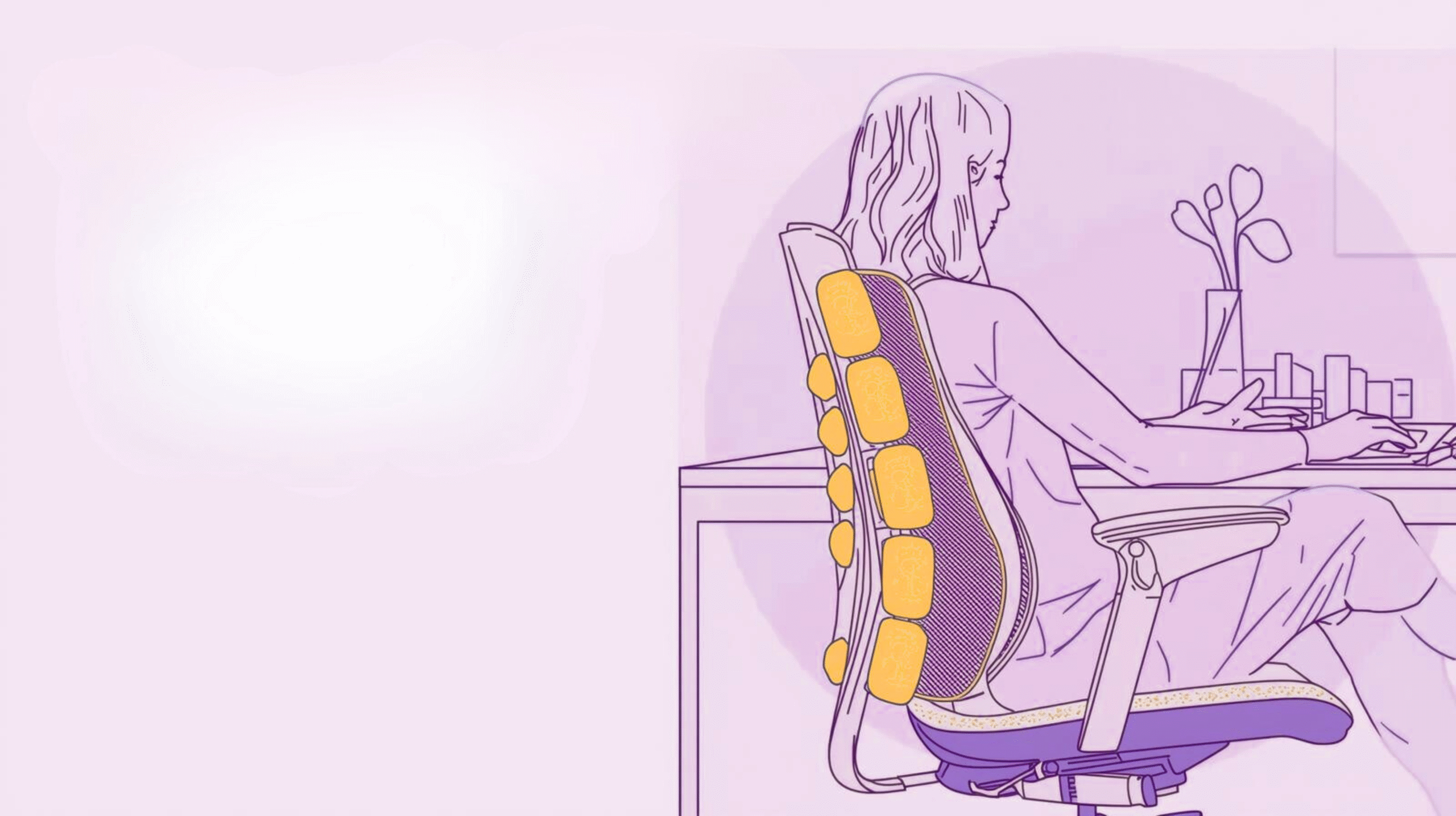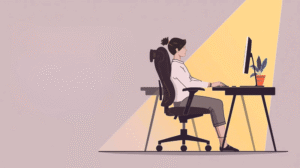Modern lifestyles demand long hours of sitting, at office desks, in cars during commutes, or while gaming or studying. While sitting may appear harmless, extended sedentary behavior puts immense strain on the spine and back muscles. Poor posture and inadequately designed chairs amplify this stress, resulting in chronic discomfort, muscle fatigue, and potential long-term spinal issues.
A memory foam backrest cushion offers a natural, ergonomic solution to these problems. Crafted from viscoelastic foam, it molds to the body’s natural curves, providing personalized support that alleviates pressure points and encourages proper spinal alignment [1]. Over time, consistent use of a memory foam backrest cushion not only relieves back pain but also enhances sitting comfort, improves posture, and promotes overall spinal health.
The purpose of this article is to provide an in-depth guide on memory foam backrest cushions: how they work, the different types available, their benefits, how to choose the right one, and strategies to maximize their effectiveness. Whether for office work, travel, or home use, this guide helps readers understand why investing in a high-quality cushion is essential for long-term back health.
Understanding Back and Posture Discomfort
Why Back Pain Happens While Sitting
Back pain from prolonged sitting primarily stems from weak lumbar muscles and insufficient lower back support. Without reinforcement, the spine flattens and intervertebral discs bear excessive pressure [2]. Poor posture habits such as slouching, leaning forward, or sitting with uneven weight distribution exacerbate the problem. Additionally, chairs without ergonomic design fail to support the spine’s natural curves, further contributing to discomfort and fatigue.
Effects of Poor Posture
Poor posture impacts both physical comfort and overall well-being:
- Chronic lower back pain: Continuous pressure on the lumbar spine leads to soreness, stiffness, and long-term pain.
- Neck and shoulder tension: Forward-head posture often accompanies slouching, straining upper back muscles.
- Fatigue and decreased productivity: Muscular overcompensation consumes energy, reducing concentration and work efficiency.
- Long-term musculoskeletal problems: Misalignment and weak postural muscles can lead to herniated discs, sciatica, and spinal curvature issues.
Importance of Proper Spinal Alignment
Proper spinal alignment preserves the spine’s natural curves, reducing muscular strain and promoting efficient weight distribution [3][4]. Supporting the lumbar region prevents the collapse of the lower spine, enhances posture, and mitigates pain. Over time, maintaining proper alignment reduces the risk of chronic musculoskeletal disorders and improves overall physical health.
What Is a Memory Foam Backrest Cushion?

A memory foam backrest cushion is made from viscoelastic foam, which is highly responsive to body heat and pressure. This allows the cushion to mold to the unique contours of your back, offering customized support. Unlike traditional foam, memory foam returns to its original shape after use, providing consistent comfort and support over extended periods.
How It Works
Memory foam cushions work by distributing body weight evenly across the lumbar and back regions, alleviating pressure points that often lead to discomfort or pain. By filling gaps between the chair and the spine, these cushions maintain natural spinal alignment and reduce strain on postural muscles.
Types of Memory Foam Backrest Cushions
1. Lumbar Cushions
Lumbar cushions are specifically designed to support the lower back, where the spine naturally curves inward. They relieve pressure on the lumbar discs, prevent slouching, and promote proper spinal alignment. Ideal for office chairs, car seats, or study setups, these cushions are lightweight, portable, and particularly helpful for individuals with lower back pain or sedentary work habits.
2. Full Back Cushions
Full back cushions extend support from the upper spine to the lower back, providing comprehensive coverage for long sitting sessions. They distribute body weight evenly across the entire back, reducing muscle fatigue and tension. These cushions are perfect for people who sit for extended periods at workstations, in gaming chairs, or in vehicles, offering all-around comfort and improved posture.
3. Orthopedic Cushions
Orthopedic memory foam cushions are designed with therapeutic contours based on ergonomic and medical research. They provide targeted support for both the lumbar and thoracic regions, helping correct postural imbalances and alleviate chronic back pain. Suitable for individuals recovering from spinal injuries, dealing with scoliosis, or requiring professional-grade support, these cushions combine comfort with health-focused functionality.
Benefits of Using a Memory Foam Backrest Cushion
1. Enhanced Posture and Spinal Support
Memory foam cushions encourage upright sitting by filling the natural lumbar gap. This reduces slouching and forward-leaning postures. Consistent use realigns the spine naturally, promoting balance and long-term postural health [5].
2. Pain Relief and Pressure Reduction
By conforming to the body’s contours, memory foam cushions relieve tension in the lumbar region, shoulders, and mid-back. They evenly distribute body weight, preventing concentrated pressure on the spine and intervertebral discs. Users often experience relief from chronic lower back pain, stiffness, and postural discomfort.
3. Comfort and Productivity Boost
Prolonged sitting can cause fatigue and distraction. Memory foam cushions reduce discomfort, allowing users to focus on work, studies, or tasks without constant pain interruptions. Their ergonomic support enhances comfort for office use, home workstations, car rides, or gaming sessions.
4. Durable and Long-Lasting Material
High-density memory foam maintains its shape over years, resisting flattening and deformation. This durability ensures that the cushion continues to provide consistent support, making it a worthwhile investment for long-term spinal health.
How to Choose the Right Memory Foam Backrest Cushion
Factors to Consider
- Firmness and density: Choose a cushion that balances support and comfort, preventing bottoming out or excessive softness.
- Contoured shape: Ensure the cushion provides support for both lumbar and thoracic regions.
- Breathable, removable covers: Covers that allow airflow prevent heat buildup and are easy to clean.
Suitability for Different Environments
Memory foam backrest cushions can be used in a variety of settings:
- Office chairs: Support long hours of desk work.
- Gaming setups: Provide comfort during extended gaming sessions.
- Wheelchairs or medical seating: Offer therapeutic support for mobility-impaired users.
- Car seats: Reduce fatigue and lower back strain during commutes or long drives.
When to Seek Professional Guidance
Individuals with persistent or chronic back pain should consult a medical professional before choosing a cushion [6]. Physical therapists and orthopedic specialists can recommend the most appropriate ergonomic type and density for individual needs.
Proper Use and Maintenance for Maximum Benefits
How to Use It Correctly
- Position the cushion at the natural curve of your lower back.
- Adjust straps for stability and comfort to prevent sliding.
- Use daily for consistent posture correction and spinal support.
Maintenance Tips
- Wash removable covers regularly to maintain hygiene.
- Avoid prolonged exposure to direct sunlight or excessive heat, which can degrade foam.
- Replace the cushion every few years to ensure optimal support.
Complementary Lifestyle Tips for Better Back Health
1. Maintain an Ergonomic Workspace
Keep your screen at eye level, elbows close to your body, and knees bent at 90° with feet flat on the floor. Proper chair height and lumbar support help reduce spinal strain and promote neutral spine alignment.
2. Take Short Breaks Every 30–60 Minutes
Stand, stretch, or walk briefly to relieve tension and improve circulation [7]. Regular movement prevents stiffness and boosts energy during long sitting sessions.
3. Strengthen Core Muscles
Exercises like planks, bridges, and pelvic tilts strengthen core muscles that support the spine. A strong core reduces pressure on the lower back and enhances posture.
4. Practice Mindful Posture Awareness
Consciously maintain a neutral spine while sitting, standing, or walking. Mindful posture helps prevent slouching and reduces long-term back strain.
Conclusion
A memory foam backrest cushion is a highly effective solution for improving posture, relieving back pain, and enhancing sitting comfort. By understanding how to select, use, and maintain the right cushion, individuals can enjoy long-term spinal support, reduced discomfort, and improved productivity in daily life. Incorporating ergonomic strategies, lifestyle adjustments, and complementary exercises ensures maximum benefits from your memory foam cushion.
Looking for more health and wellness solutions? Don’t miss these related guides:-
Frequently Asked Questions:
1. What is a memory foam backrest cushion, and how does it support the spine?
It molds to the body’s natural curve, filling the lumbar gap and maintaining proper spinal alignment, reducing muscle strain.
2. Can a memory foam cushion relieve chronic lower back pain?
Yes, it alleviates tension and distributes pressure evenly, which helps reduce chronic lower back discomfort.
3. Is it suitable for office chairs and long sitting hours?
Absolutely. Memory foam cushions are ideal for office, gaming, and car chairs.
4. How do I properly position a backrest cushion for best results?
Place it at the lumbar curve, adjust straps for stability, and ensure it supports the lower spine without pushing the mid-back.
5. How long does a memory foam backrest cushion last?
High-density cushions typically last 3–5 years, depending on usage and maintenance.
References:
- betterhood. (2025). The science behind ergonomic lumbar cushions. https://betterhood.in/learn/science-behind-ergonomic-lumbar-cushions/
- Everlasting Comfort. (2020). Is memory foam good for lumbar support? https://everlastingcomfort.com/blogs/comfy-reads/lumbar-support-2
- Everlasting Comfort. (2020). Here are 4 reasons why you need a back gel cushion. https://everlastingcomfort.com/blogs/comfy-reads/back-gel-cushion
- The Cushion Lab. (2021). 3 benefits of a back support pillow according to chiropractors. https://thecushionlab.com/blogs/back-pain/back-support-pillow
- Performance Health. (n.d.). Mesh back cushion – lumbar support. https://www.performancehealth.com/mesh-back-cushion
- Mayo Clinic Store. (n.d.). Nova Happy Back Gel Cushion. https://store.mayoclinic.com/nova-happy-back-gel-cushion.html
- Autonomous. (2024). Are mesh back office chairs with lumbar support good? https://www.autonomous.ai/ourblog/are-mesh-office-chairs-with-lumbar-support-good-for-your-back



















